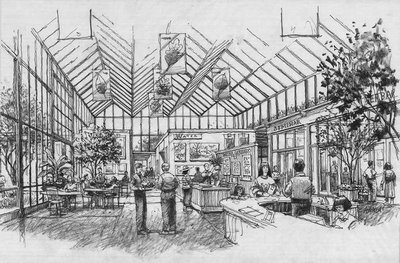July 1, 2002
Donor tiles paving way for better service to gardeners at UW
The University of Washington’s Center For Urban Horticulture has spent the past year re-creating and reconnecting — work that’s far from done even many months after the May 21, 2001, arson attack damaged the center’s main building, rendering most if it beyond repair.
Donors ranging from those able to write checks for $15 to the ones able to contribute thousands have given more than $400,000 to make the new building bigger and add enhancements not possible within the basic budget.
Now, as part of a just-announced drive, donors can purchase floor tiles with leaf designs and engraved with their names to pave the way for an expanded lobby, one that will make it easier to get information about plants, gardens and urban forests. An enhanced lobby will be a place to showcase programs and services offered by the center, Washington State University-King County Cooperative Extension and Master Gardener programs, according to center director Tom Hinckley.
Learn about the plans and donor tile drive at http://www.urbanhort.org.
Fifty faculty members, staff and graduate students lost books papers and workspace after the May 2001 fire. Years of research on ecosystem health and plant science were destroyed or damaged, Hinckley says. Today, a bare cement foundation sits where Merrill Hall’s labs and offices once stood. The section of Merrill Hall that housed the library and herbarium – an herbarium stores pressed plant samples for reference – remains but is unusable.
In addition to the $5.4 million appropriated by the UW and Legislature for rebuilding, the UW spent more than $1.2 million to recover materials from the damaged hall, obtain work and office space, pay salaries for recovery work and demolish unsafe portions of Merrill, Hinckley says.
Six months after the fire, the herbarium and library reopened on a limited scale in Issacson Hall, one of the small buildings at the center that did not catch fire, after the Northwest Horticultural Society, Seattle Garden Club and Puget Sound Mycological Society loaned their space in the hall for the center’s use.
The library will be at least 25 percent larger when rebuilt with direct funds and a matching-fund challenge to other donors from the Miller Charitable Fund of Seattle. And the Northwest Horticultural Society established a fund with $55,000 and a commitment to raise $200,000 for library furnishings and shelving.
Washington State University has pledged to raise money to expand the space for its community gardening program and the new, non-profit Master Gardener Foundation is contributing $80,000 and will have its offices at the center.
Donations can be sent to Center for Urban Horticulture – Recovery, University of Washington Box 354115, Seattle, WA 98195-4115, for such things as:
• Landscaping to provide a needed transition from the dense neighborhoods on one side to the wetlands and natural area on the Union Bay side.
• Rebuilding using concepts of green architecture and resource conservation.
The investigation into the arson continues, led by the federal Bureau of Alcohol, Tobacco and Firearms in cooperation with the UW police and FBI. UW’s Lt. John Schultz said ATF has had a few people of interest but there are no suspects at this time.
Members of the terrorist group Earth Liberation Front claimed responsibility for the fire a year ago and said they targeted the office of research associate professor Toby Bradshaw. They accused Bradshaw of genetically engineering poplar trees – that is inserting the trees with poplar genes that had been changed in some way in the laboratory or by inserting genes from entirely different plants, insects or animals. U.S. law says such transgenic trees may be used for research but can’t be released into the environment. Bradshaw was not genetically engineering poplar trees at the center but is interested in the technique as a research tool for understanding tree genetics.
Bradshaw has long used traditional tree-breeding techniques for studying the basic biology of poplar trees and trying to determine the genes that power such things as leaf size, growth and other characteristics. Poplar trees are far easier to work with than, say, Douglas-fir trees, which is what makes poplars such a good model for studying how genes express themselves in all trees.
The fire in Bradshaw’s office rapidly spread to labs and offices where faculty, staff and students from the UW and Washington State University conducted work on such things as preserving Washington’s endangered plants, finding ways to re-establish native grasses and plants in the region’s prairies where invasive non-natives now reign, rehabilitating wetlands and natural areas in our cities, and helping home gardeners and landscape professionals.
###
For more information:
Hinckley, 206-543-1588, hinckley@u.washington.edu (he’s out of the country until July 9)
Sue Nicol, outreach coordinator, 206-543-3889, snicol@u.washington.edu (she’s out of the office the week of July 4)
Sarah Reichard, assistant professor, 206-616-5020, reichard@u.washington.edu
About arson attack:
http://www.washington.edu/newsroom/news/2001archive/06-01archive/k060101a.html



